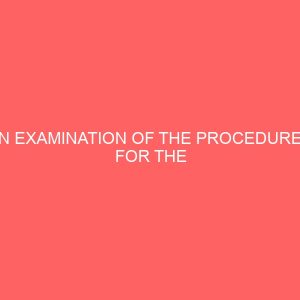Description
ABSTRACT
Recent studies have reputed the seed oil of Citrus sinensis to be a good source of essential fatty acids. This study was carried out to investigate the antidiabetic effect of Citrus sinensis seed oil in alloxaninduced diabetic rats. Diabetes mellitus was induced in 18 adult male rats, using intraperitoneal injection of 120mg/kg body weight BW alloxan. The diabetic rats were randomly assigned into three diabetic and one control groups of six rats each; normal control, diabetic treated with 1000mg/kg body weight of emulsified seed oil, diabetic control, diabetic treated with 150mg/kg body weight of metformin hydrochloride. Both controls received weight checked solution of 4.8 v/v Tween80 in distilled water. Administration in all groups were done intraperitoneally once daily for 28 days 4 weeks. After 4weeks, lipid profiles and some liver enzymes activities AST, ALT and ALP were analysed using test kits and spectrophotometer. The weight change and histopathological studies on the pancreas and spleen were also evaluated in addition to fasting blood glucose estimation every week. Data were analyzed using Oneway ANOVA followed by Tukeys post hoc test using GraphPad Prism demo version 6.00 for Windows .The results of this study indicated that Citrus sinensis seed oil was able to reduce blood glucose significantly Plt;0.001 in the early weeks of the study when compared with both the diabetic control group and the metformintreated group. The seed oil significantly lowered serum triglyceride and VLDLcholesterol; the activities of all the liver enzymes assayed Plt;0.05; had no significant effect on the HDLcholesterol but increased the serum LDLcholesterol and total cholesterol level in diabetic rats as compared to control Plt;0.05.The standard drug metformin had a favorable lipid profile than the oil. Histopathological study of diabetic untreated rats revealed degeneration of pancreatic cells, which was due to alloxan used in this experiment. However the pancreas of the diabetic oil treated rats did not show a significant difference with the untreated diabetic rats. The pancreas and spleen of the oil treated rat showed mild atrophy when compared with that of the normal and metformin treated rats. In conclusion, this study demonstrated that Citrus sinensis seed oil had some antidiabetic effects in alloxaninduced diabetic albino rats but also had toxic effects on tissues like the pancreas and spleen.
TABLE OF CONTENTS PAGE
DEDICATION i
LIST OF FIGURES ii
LIST OF TABLES iii
ACKNOWLEDGEMENT ix
ABSTRACT x
CHAPTER ONE
Introduction 1
1.2 Description of plant 4
1.3 Statement of the problem 4
1.4 Justification of the study 5
1.5 Aims and objectives 6
CHAPTER TWO
2.0 Literature Review 7
2.1 Classification and pathogenesis of diabetes 7
2.1.1 Type I diabetes 7
2.1.2 Type II diabetes 8
2.1.3 Other types of diabetes mellitus 8
2.2 Chemically induced diabetes 12
2.3 Mechanism of diabetogenic action of alloxan 13
2.4 Pathophysiology and complications in diabetes 14
2.5 Oxidative stress and diabetes mellitus 16
2.5.1 Production of glycation end products 17
2.5.2 Polyol/Aldose pathway 18
2.5.3 Activation of protein kinase C 18
2.5.4 Increased flux through the Hexosamine pathway 19
2.6 Management of diabetes mellitus 22
2.6.1 Dietary modification 22
2.6.2 Pharmacological treatment of type II diabetes and limitations 23
2.6.3 Herbal intervention and consequences 24
2.6.3.1 Leave extracts 25
2.6.3.2 Seed extracts 26
CHAPTER THREE
3.0 Materials and Methods 28
3.1 Collection and identification of plant material 28
3.2 Drugs and chemicals 28
3.3 Materials 29
3.3.1 Experimental animals 30
3.4 Extraction of oil 30
3.5 Physicochemical properties of oil 31
3.5.1 Percent oil yield 31
3.5.2 Determination of pH 31
3.5.3 Determination of specific gravity 31
3.5.4 Determination of solvent miscibility 32
3.5.5 Determination of acid value 32
3.5.6 Determination of free fatty acid 33
3.5.6 Determination of saponification value 33
3.6 Preparation of oil water emulsion 34
3.7 Whole animal experiment 34
3.7.1 Acute toxicity studies 34
3.7.2 Experimental induction of diabetes 35
3.7.3 Antidiabetic study 36
3.8 Body weight analysis 37
3.9 Measurement of blood glucose 37
3.10 Measurement of serum lipid profile 37
3.11 Measurement of liver enzyme activity 38
3.12 Histopathological evaluation 38
3.13 Statistical analysis 39
CHAPTER FOUR
Results
4.1 Physicochemical analysis of oil 40
4.2 Acute toxicity test 42
4.3 Weight analysis 42
4.4 Fasting blood glucose 44
4.5 Lipid profile 51
4.6 Enzyme activities 53
4.7 Pancreas and Spleen histology 55
CHAPTER FIVE
Discussion 64
5.1 Conclusion 70
LIST OF REFERENCES 71
LIST OF APPENDICES 80
LIST OF FIGURES
Figure 2.1 Pathogenesis of type 1 diabetes 10
Figure 2.2 Pathogenesis of type 2 diabetes 11
Figure 2.3 Polyol pathwayinduced oxidative stresses 20
Figure 2.4 Formation of Advanced Glycation End Products 21
Figure 4.1 Variation in weekly mean fasting blood glucose in group A 47
Figure 4.2 Variation in weekly mean fasting blood glucose in group B 48
Figure 4.3 Variation in weekly mean fasting blood glucose in group C 49
Figure 4.4 Variation in weekly mean fasting blood glucose in group D 50
Figure 4.5.1 Photomicrograph of Hamp;Estained group A pancreas tissue 56
Figure 4.5.2 Photomicrograph of Hamp;Estained group A spleen tissue 57
Figure 4.5.3 Photomicrograph of Hamp;Estained group B pancreas tissue 58
Figure 4.5.4 Photomicrograph of Hamp;Estained group B spleen tissue 59
Figure 4.5.5 Photomicrograph of Hamp;Estained group C pancreas tissue 60
Figure 4.5.6 Photomicrograph of Hamp;Estained group C spleen tissue 61
Figure 4.5.7 Photomicrograph of Hamp;Estained group D pancreas tissue 62
Figure 4.5.8 Photomicrograph of Hamp;Estained group D spleen tissue 63
LIST OF TABLES
Table 4.1: Physicochemical characteristics of Citrus sinensis seed oil 41
Table 4.2: Mean body weight in grams of each group per week 43
Table 4.3: Fasting blood glucose of the groups per week 46
Table 4.4: Lipid profile for each group at the end of 4 weeks 52
Table 4.5: Enzyme Activities 54








Reviews
There are no reviews yet.